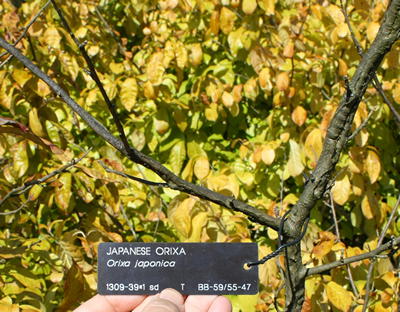Japanese Orixa – Orixa japonica
This Japanese orixa, in fall colors, was started from seed in 1939 [1]
Family Rutaceae – Cork & Citrus
Orixa is a deciduous shrub growing to 3m tall and equally wide. Hardy in Zones 5a – 7b.
Native to Japan, Korea, and southwest China, orixa is a medium-sized deciduous shrub that likes sun to partial shade and rich, well-drained soil. Useful for a hedge or screen as well as specimen with spectacular yellow autumn colors. This hardy shrub in dioecious, so both male and female plants are required to produce seed.
A Japanese scientific study of this plant’s chemical components revealed 14 different alkaloids, among them ten isolated for the first time. Two of these new quinoline alkaloids showed inhibiting activity against Plasmodium falciparum, [2] one of the species of protozoan parasites that cause human malaria [3].
Two other compounds (eduline and japonine) found in the assay were discovered to have antispasmodic properties equal to papaverine [4], an alkaloid derived from the opium poppy first synthesized in 1848 and today used to treat muscle spasms and erectile dysfunction [2]. Papervine, like other opioids, can have significant side effects, including constipation, sleepiness and vertigo. It is for this reason the search for equally effective but less harmful drugs is important.
Abstract; “During the study of the alkaloidal constituents of Orixa japonica (Rutaceae), 14 alkaloids have been isolated from the various parts of this plant. Among these alkaloids, five alkaloids are new naturally occurring compounds and ten alkaloids were isolated from this plant material for the first time.” [2]

References
- Japanese Orixa, Morton Arboretum accession 1309-39-1, photos by Bruce Marlin
- Funayama Shinji, Noshita Toshiro, Mori Tetsuya et al, “Quinoline alkaloids from Orixa Japonica”
- Wikipedia, Plasmodium falciparum
- Wikipedia, Papaverine
Family Rutaceae – Cork & Citrus
Plants in this family are herbs, shrubs, and trees with commonly odoriferous herbage comprising about 150 genera and 1,500 species; further characterized by the common occurrence of spines and winged petioles. The Citrus genus includes the agriculturally important fruit trees: orange, lime, grapefruit, kumquat, and mandarine.
Family Rosaceae – Rose Family; Fruit Trees
Trees Index | Pine Family | Beech, Oak | Nut Trees | Birch Family | Magnolias
Tree Encyclopedia / North American Insects & Spiders is dedicated to providing family-friendly educational
resources for our friends around the world through large images and macro photographs of flora and fauna.

